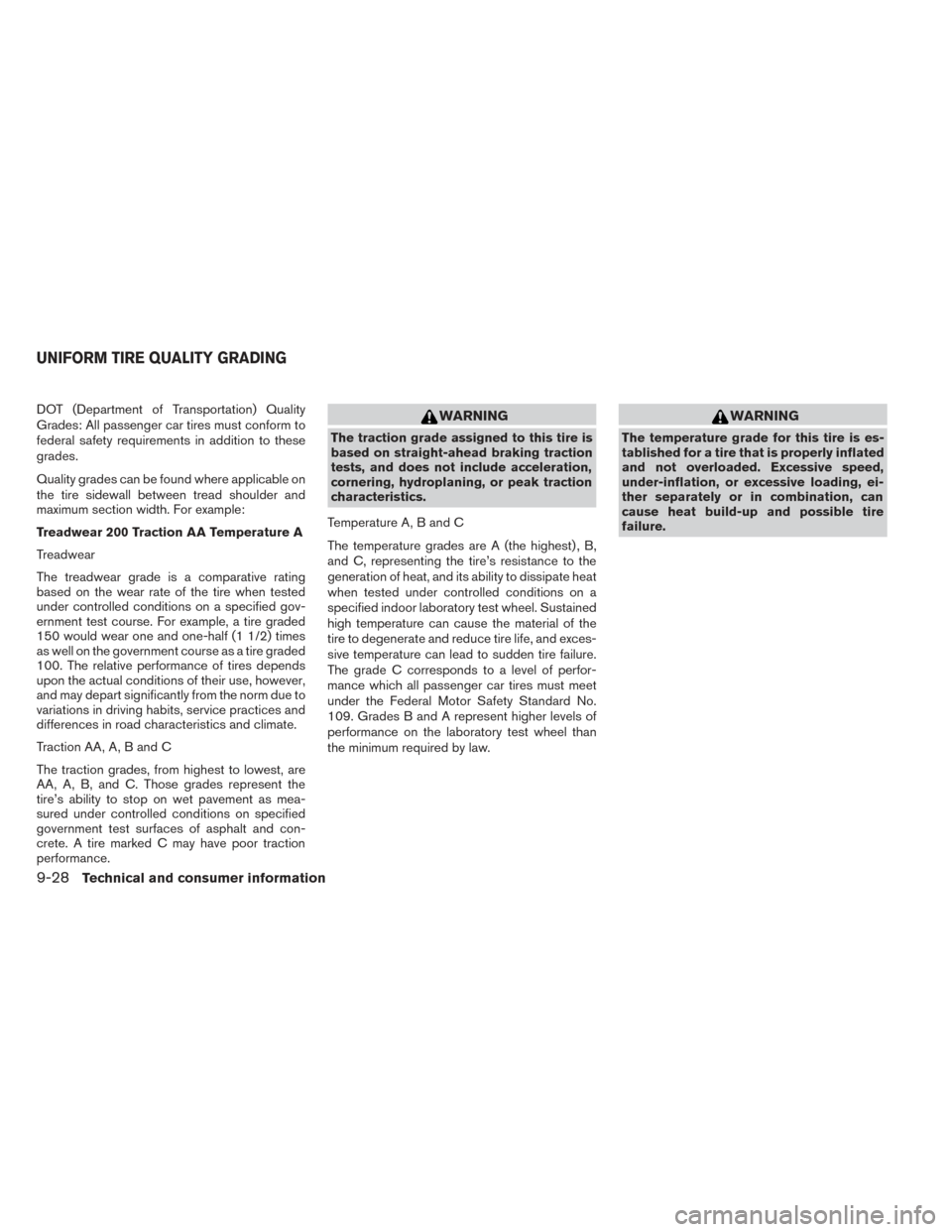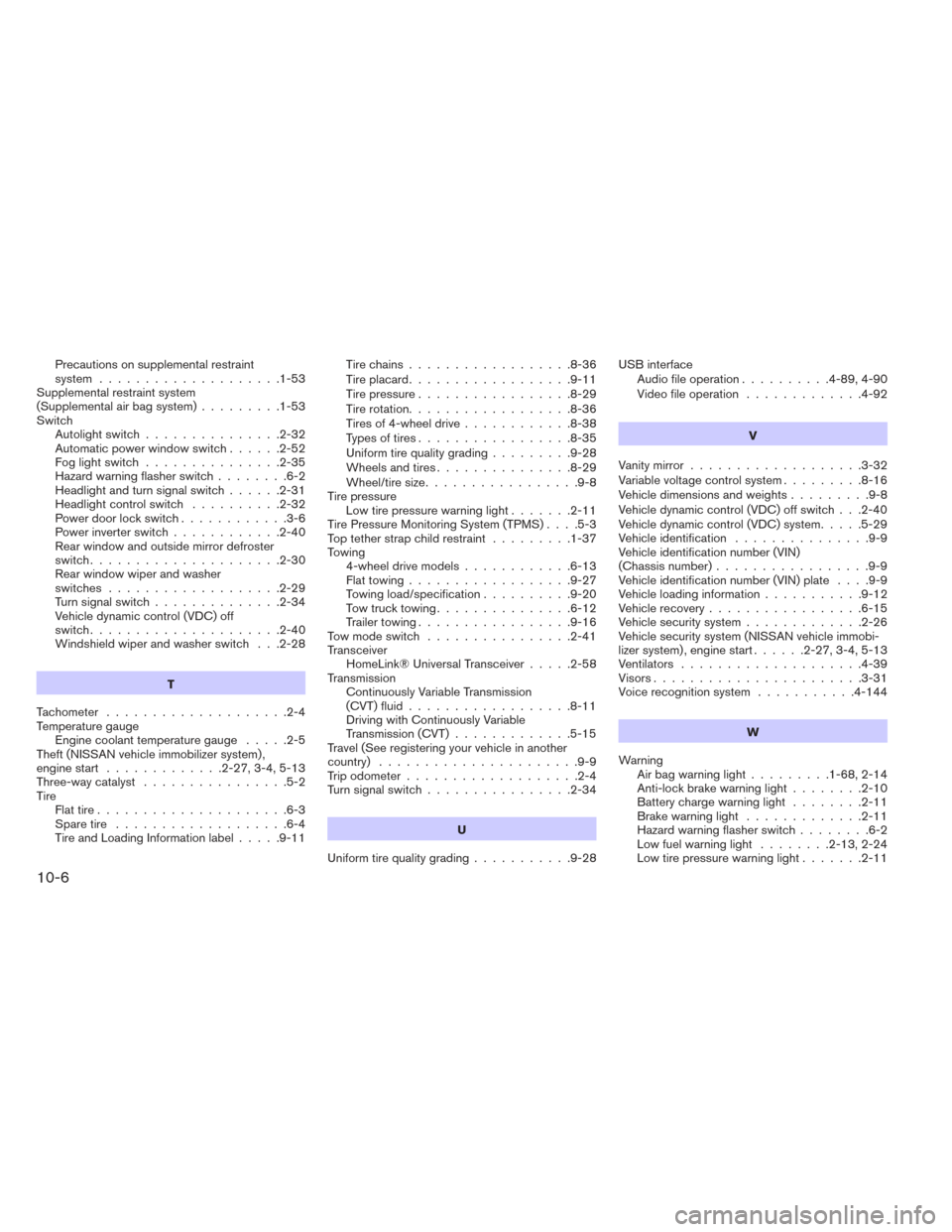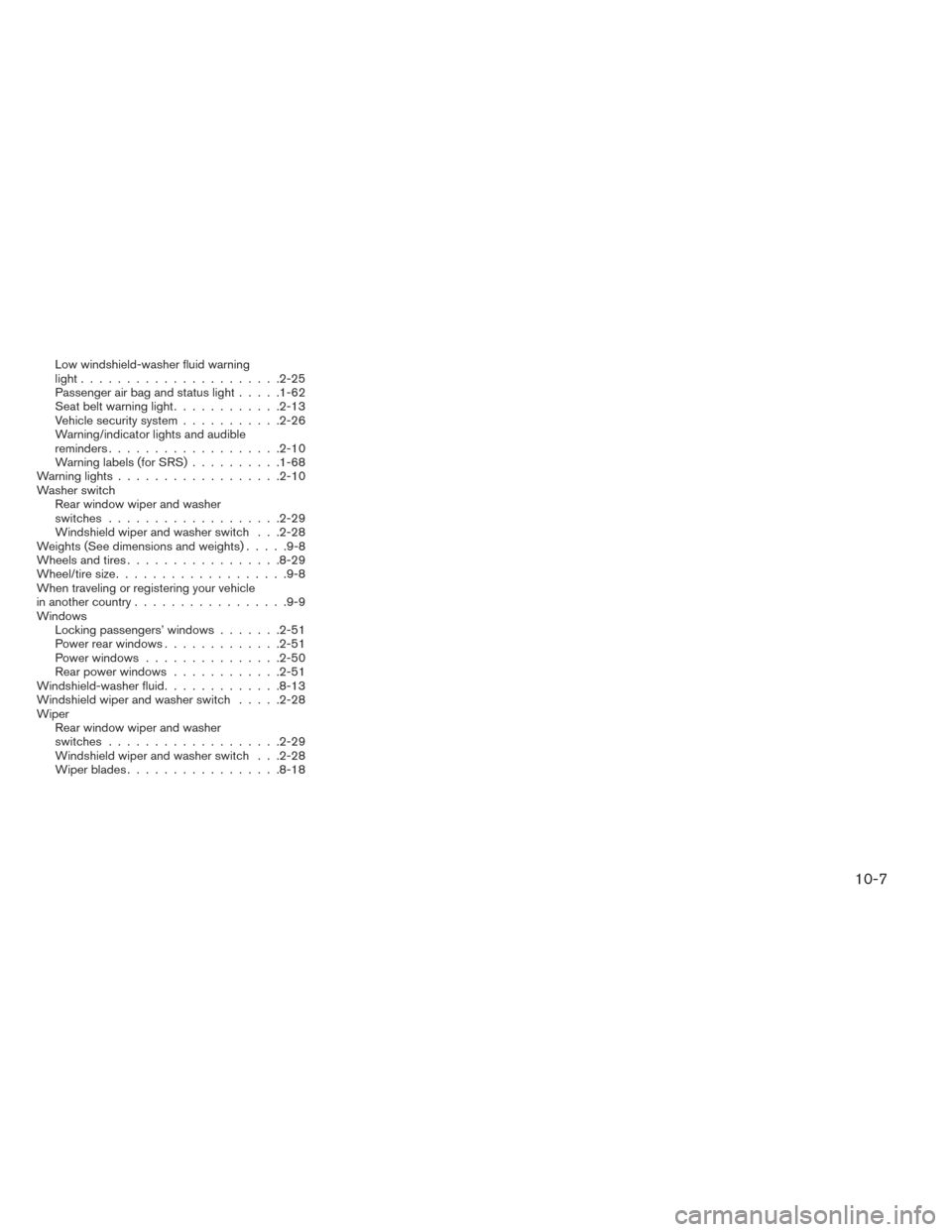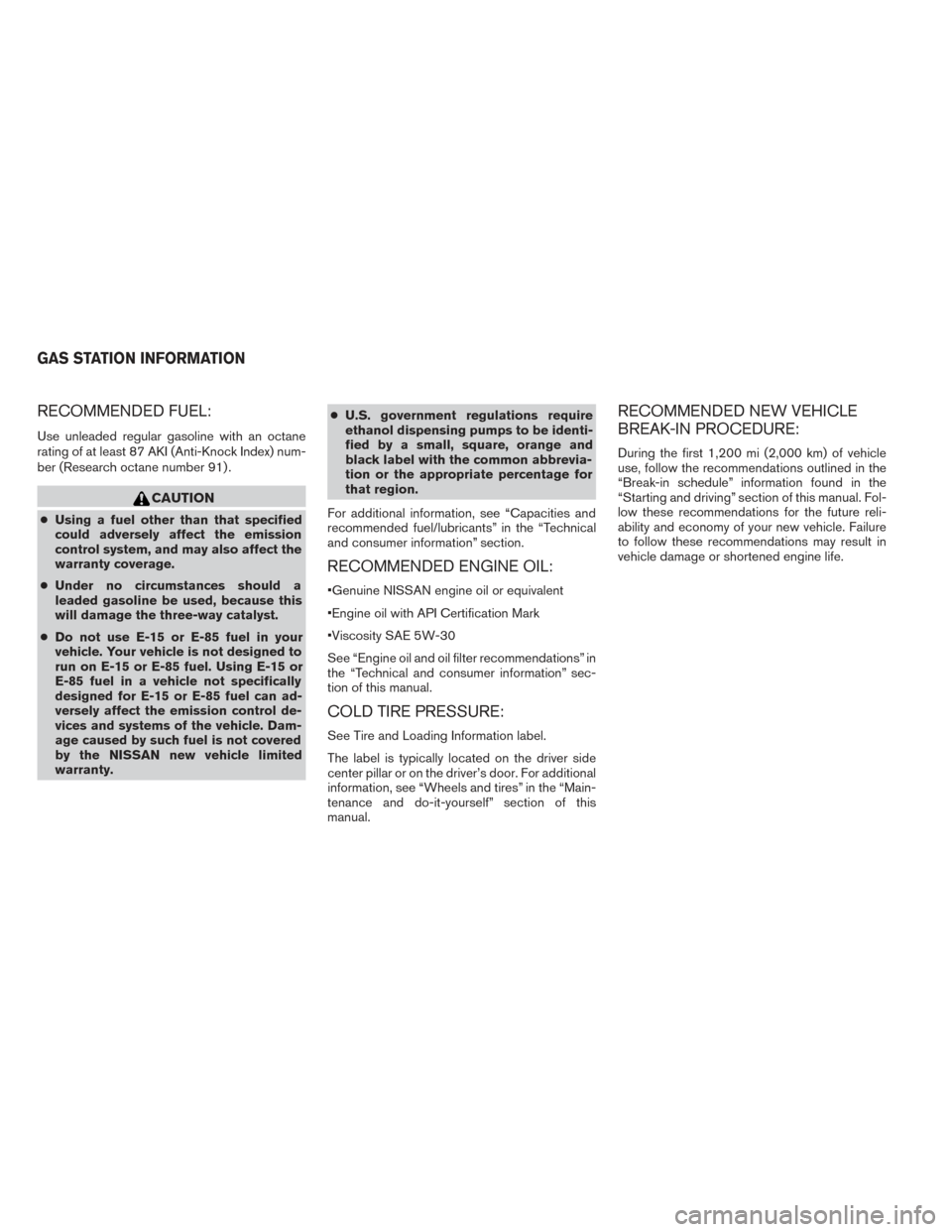2014 NISSAN PATHFINDER HYBRID tires
[x] Cancel search: tiresPage 558 of 571

DOT (Department of Transportation) Quality
Grades: All passenger car tires must conform to
federal safety requirements in addition to these
grades.
Quality grades can be found where applicable on
the tire sidewall between tread shoulder and
maximum section width. For example:
Treadwear 200 Traction AA Temperature A
Treadwear
The treadwear grade is a comparative rating
based on the wear rate of the tire when tested
under controlled conditions on a specified gov-
ernment test course. For example, a tire graded
150 would wear one and one-half (1 1/2) times
as well on the government course as a tire graded
100. The relative performance of tires depends
upon the actual conditions of their use, however,
and may depart significantly from the norm due to
variations in driving habits, service practices and
differences in road characteristics and climate.
Traction AA, A, B and C
The traction grades, from highest to lowest, are
AA, A, B, and C. Those grades represent the
tire’s ability to stop on wet pavement as mea-
sured under controlled conditions on specified
government test surfaces of asphalt and con-
crete. A tire marked C may have poor traction
performance.WARNING
The traction grade assigned to this tire is
based on straight-ahead braking traction
tests, and does not include acceleration,
cornering, hydroplaning, or peak traction
characteristics.
Temperature A, B and C
The temperature grades are A (the highest) , B,
and C, representing the tire’s resistance to the
generation of heat, and its ability to dissipate heat
when tested under controlled conditions on a
specified indoor laboratory test wheel. Sustained
high temperature can cause the material of the
tire to degenerate and reduce tire life, and exces-
sive temperature can lead to sudden tire failure.
The grade C corresponds to a level of perfor-
mance which all passenger car tires must meet
under the Federal Motor Safety Standard No.
109. Grades B and A represent higher levels of
performance on the laboratory test wheel than
the minimum required by law.
WARNING
The temperature grade for this tire is es-
tablished for a tire that is properly inflated
and not overloaded. Excessive speed,
under-inflation, or excessive loading, ei-
ther separately or in combination, can
cause heat build-up and possible tire
failure.
UNIFORM TIRE QUALITY GRADING
9-28Technical and consumer information
Page 568 of 571

Precautions on supplemental restraint
system ....................1-53
Supplemental restraint system
(Supplemental air bag system) .........1-53
Switch Autolightswitch...............2-32
Automatic power window switch ......2-52
Foglightswitch ...............2-35
Hazard warning flasher switch ........6-2
Headlight and turn signal switch ......2-31
Headlightcontrolswitch ..........2-32
Power door lock switch ............3-6
Power inverter switch ............2-40
Rear window and outside mirror defroster
switch.....................2-30
Rear window wiper and washer
switches ...................2-29
Turnsignalswitch..............2-34
Vehicle dynamic control (VDC) off
switch.....................2-40
Windshield wiper and washer switch . . .2-28
T
Tachometer ....................2-4
Temperature gauge Engine coolant temperature gauge .....2-5
Theft (NISSAN vehicle immobilizer system) ,
engine start .............2-27,3-4,5-13
Three-way catalyst ................5-2
Tire Flat tire .....................6-3
Spare tire ...................6-4
Tire and Loading Information label .....9-11Tirechains..................8-36
Tireplacard..................9-11
Tire pressure
.................8-29
Tire rotation..................8-36
Tires of 4-wheel drive ............8-38
Types of tires .................8-35
Uniform tire quality grading .........9-28
Wheels and tires ...............8-29
Wheel/tire size .................9-8
Tire pressure Low tire pressure warning light .......2-11
Tire Pressure Monitoring System (TPMS) ....5-3
Top tether strap child restraint .........1-37
Towing 4-wheel drive models ............6-13
Flattowing..................9-27
Towing load/specification ..........9-20
Towtrucktowing...............6-12
Trailer towing .................9-16
Tow mode switch ................2-41
Transceiver HomeLink® Universal Transceiver .....2-58
Transmission Continuously Variable Transmission
(CVT) fluid ..................8-11
Driving with Continuously Variable
Transmission (CVT) .............5-15
Travel (See registering your vehicle in another
country) ......................9-9
Trip odometer ...................2-4
Turn signal switch ................2-34
U
Uniform tire quality grading ...........9-28USB interface
Audio file operation ..........4-89,4-90
Video file operation .............4-92
V
Vanity mirror ...................3-32
Variable voltage control system .........8-16
Vehicledimensionsandweights.........9-8
Vehicle dynamic control (VDC) off switch . . .2-40
Vehicle dynamic control (VDC) system .....5-29
Vehicle identification ...............9-9
Vehicle identification number (VIN)
(Chassis number) .................9-9
Vehicle identification number (VIN) plate ....9-9
Vehicleloadinginformation...........9-12
V
ehicle recovery .................6-15
Vehicle security system .............2-26
Vehicle security system (NISSAN vehicle immobi-
lizer system) , engine start ......2-27,3-4,5-13
Ventilators ....................4-39
Visors.......................3-31
Voice recognition system ...........4-144
W
Warning Airbagwarninglight.........1-68, 2-14
Anti-lock brake warning light ........2-10
Battery charge warning light ........2-11
Brake warning light .............2-11
Hazard warning flasher switch ........6-2
Low fuel warning light ........2-13, 2-24
Low tire pressure warning light .......2-11
10-6
Page 569 of 571

Low windshield-washer fluid warning
light......................2-25
Passenger air bag and status light.....1-62
Seat belt warning light ............2-13
Vehicle security system ...........2-26
Warning/indicator lights and audible
reminders ...................2-10
Warning labels (for SRS) ..........1-68
Warninglights..................2-10
Washer switch Rear window wiper and washer
switches ...................2-29
Windshield wiper and washer switch . . .2-28
Weights(Seedimensionsandweights).....9-8
Wheels and tires .................8-29
Wheel/tire size ...................9-8
When traveling or registering your vehicle
in another country .................9-9
Windows Locking passengers’ windows .......2-51
Power rear windows .............2-51
Power windows ...............2-50
Rear power windows ............2-51
Windshield-washer fluid .............8-13
Windshield wiper and washer switch .....2-28
Wiper Rear window wiper and washer
switches ...................2-29
Windshield wiper and washer switch . . .2-28
Wiper blades .................8-18
10-7
Page 570 of 571

RECOMMENDED FUEL:
Use unleaded regular gasoline with an octane
rating of at least 87 AKI (Anti-Knock Index) num-
ber (Research octane number 91) .
CAUTION
●Using a fuel other than that specified
could adversely affect the emission
control system, and may also affect the
warranty coverage.
● Under no circumstances should a
leaded gasoline be used, because this
will damage the three-way catalyst.
● Do not use E-15 or E-85 fuel in your
vehicle. Your vehicle is not designed to
run on E-15 or E-85 fuel. Using E-15 or
E-85 fuel in a vehicle not specifically
designed for E-15 or E-85 fuel can ad-
versely affect the emission control de-
vices and systems of the vehicle. Dam-
age caused by such fuel is not covered
by the NISSAN new vehicle limited
warranty. ●
U.S. government regulations require
ethanol dispensing pumps to be identi-
fied by a small, square, orange and
black label with the common abbrevia-
tion or the appropriate percentage for
that region.
For additional information, see “Capacities and
recommended fuel/lubricants” in the “Technical
and consumer information” section.
RECOMMENDED ENGINE OIL:
•Genuine NISSAN engine oil or equivalent
•Engine oil with API Certification Mark
•Viscosity SAE 5W-30
See “Engine oil and oil filter recommendations” in
the “Technical and consumer information” sec-
tion of this manual.
COLD TIRE PRESSURE:
See Tire and Loading Information label.
The label is typically located on the driver side
center pillar or on the driver’s door. For additional
information, see “Wheels and tires” in the “Main-
tenance and do-it-yourself” section of this
manual.
RECOMMENDED NEW VEHICLE
BREAK-IN PROCEDURE:
During the first 1,200 mi (2,000 km) of vehicle
use, follow the recommendations outlined in the
“Break-in schedule” information found in the
“Starting and driving” section of this manual. Fol-
low these recommendations for the future reli-
ability and economy of your new vehicle. Failure
to follow these recommendations may result in
vehicle damage or shortened engine life.
GAS STATION INFORMATION